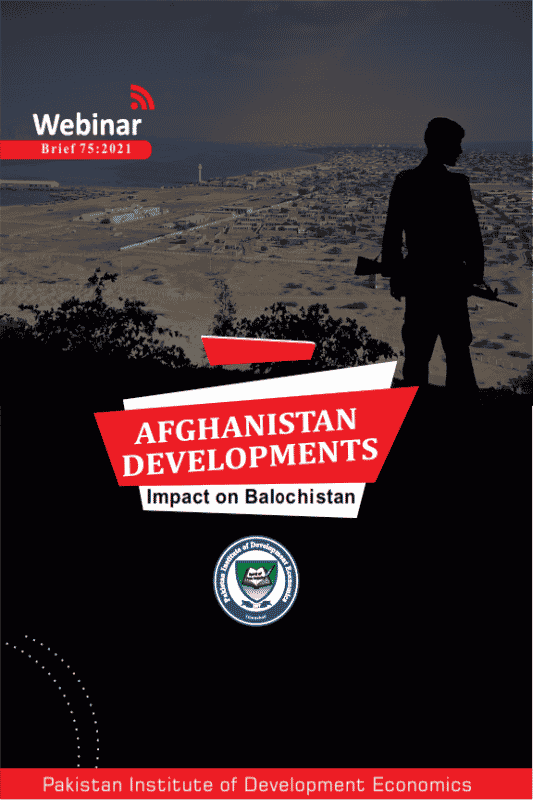Afghanistan Developments Impact on Balochistan
Publication Year : 2021
Author: Azwar Muhammad Aslam
Explore More : Webinars Brief
Afghanistan Developments: Impact on Balochistan
Preamble
This webinar was an attempt to address the following points.- The possible impact of events in Afghanistan on the region and on Pakistan, specifically on the province of Balochistan.
- Impact of Afghan refugees on Balochistan given its socio-economic conditions and demography.
Key Messages
- Even though America has abandoned Afghanistan, its imprint is still there, along with the death and destruction it left behind. It is likely to increase if Afghanistan continues to be held under sanctions; in this case, we shall expect a mass influx of refugees. After 9/11, Afghanistan has served as a launching pad to cause disturbance in Balochistan. Luckily the situation is under control for now, given that 50,000 refugees have entered Balochistan. Other than the refugees, Afghans straddle the border of Pakistan without documents under the easement rights to do their businesses and jobs.
- The informal trade between Balochistan and Afghanistan has a considerable share, along with smuggling and drugs. Balochistan is one of the lucrative markets for drugs and serves as a transit route. If the drug and opium trade is not controlled effectively, we will have many more drug peddlers and drug trade that will flow into Balochistan with the influx of refugees from Afghanistan.
- In the last three months, Balochistan had more casualties of law enforcement agencies than Balochistan had in the previous three years, which indicates how things are going in Balochistan right now. Given the recent terrorist activities, once refugees pour in, the chances of terrorists entering Pakistan also rises, which will cause an upsurge in terrorism in Balochistan.
- Tehreek-e-Taliban Pakistan (TTP) is another concern given the current events, with Afghanistan being the sanctuary for the TTP. Until now, the Taliban’s regime hasn’t provided any assurances on how it will take them to care?
- Socio-economic problems exist for Balochistan; the Baloch population is already in fear with the thought of a change of demography with the inflow of Pashtoon refugees into the province.
- Something similar to Marshall’s plan is required for the rebuilding of Afghanistan and its durable peace. Russia, China, Iran, Pakistan, and central Asian countries will directly influence the geostrategic environment of Afghanistan. They all can help to stabilize Afghanistan and perhaps even convince America to let the bygone be bygone.
- If launched, political uncertainty, witch hunting, and violence will suppress the economic activity across the border. All the surrounding countries will pay the price by the massive influx of refugees. An increase in violence in Afghanistan will have an impact on KPK and Balochistan. Balochistan has added strategic significance, given the role it played in CPEC. Stability in Balochistan is highly critical given the development of CPEC.
- Unlike KPK, whose socio-economic condition will also be stressed with the arrival of refugees, the situation of Balochistan is very delicate, where various communities co-exist. With the influx of refugees, the delicate balance in Balochistan will be disturbed, which is little different than the situation in KPK. Like, the Hazara community of Balochistan has already faced difficulties in the past. If the Hazara community of Afghanistan is compelled to migrate, they would prefer going into Balochistan rather than any other area.
- The Hazara community in Afghanistan has one militant group in Afghanistan, which is called Fatim Noon Brigade. They have already established their footprints in Balochistan for the last two years. Hence, we need to be proactive in Balochistan; we can’t be reactive as the impact of events in Afghanistan is immense on Balochistan.
- As per UNHCR, there are 40 million people in Afghanistan, and out of these 40 million, 20 million are surviving on foreign AID. That raises the concern for food security. So considering the problem of food insecurity is essential as if it is not addressed, it will lead to the smuggling of food (wheat and rice) from Pakistan as happened in the past.
Conclusion
The current development in Afghanistan is positive from the perspective of Pakistan, given that the problem that may exist or arise in the future will be far less complex than the presence of the U.S and India in Afghanistan. Refugees’ influx can’t be stopped by force. Still, the way forward is to facilitate them by specifying the regions and areas where they can stay and do business, restraining them from the other regions, formally documenting the refugees entering Pakistan, and welcoming them to areas of our strength. The unfolding situation in Afghanistan is not very bad but can not be ruled out the possibility of worsening.
© 2024 Pakistan Institute of Development Economics




